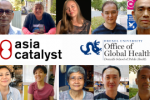by Gisa Hartmann
An integral part of Asia Catalyst’s approach to assisting organizations to become stronger and more effective is teaching groups how to create a simple strategic plan. Having just returned from an intensive working trip to China, and having also participated in AC’s strategic planning meetings with Phoenix in China, with IKON in Bali, and with Thai AIDS Treatment Action Group (TTAG) in New York, I have noticed some issues that appear to be integral to the process, even for diverse groups in different parts of Asia.
Asia Catalyst uses a one-page “logic model” form to help groups develop their strategic plan. The basic idea behind this is that it helps the organization come together on a long-term goal, and then break down an organization’s vision into mid- and short-term milestones that function as stepping stones. Through these milestones, all of the activities of an organization in the current year should be connected to and focused on one long-term goal. With a specific impact in mind, the model moves back in time toward the present, establishing three to four specific five-year outcomes, clearly defined and measurable two-year outputs, strategies and activities for the upcoming year, and allies and other resources the organization can rely on.
Strategic planning helps an organization to make choices and add focus to its activities. Of course NGOs are founded by passionate people with a strong belief in their work. However, without a concrete plan on how to realize your vision, it is easy to get distracted by opportunities along the way.
For example, a donor offers funding for a new project. While this project may seem worthwhile, and receiving funding to keep the organization running is crucial, the project the donor wants to fund may not contribute to realizing the organization’s long-term vision.
Also, the NGOs we work with are small operations with limited staff and resources. Without a clear strategy and timeline to guide their work, they are also in danger of becoming crisis-driven, and their long-term goal may drop out of sight. This appears to be particularly the case for NGOs working with communities that are subject to multiple vulnerabilities and that therefore have multiple problems to solve.
Strategic planning is very much about making decisions and admitting that one cannot do everything. Members and leaders of NGOs that have not been operating for a long time can easily get overwhelmed by the extent of the issues they want to tackle and feel pressured by the responsibilities they face. Learning to say “no” to certain activities or demands is not an easy single-day process, and it can involve making tough decisions.
The hardest step for an organization is to often coming up with two-year outputs – which have to be achievable results deriving from this year’s program work — because it means deciding against one set of activities in favor of another. Sometimes it happens that organizations realize that some of their core projects do not contribute to their mission. In this case, they have to go back and either change their mission, or change their program approach.
While we mostly work with new groups, strategic planning is useful for organizations in more advanced stages of operations as well. In the course of their work, NGOs that started out mainly providing frontline services to their community sometimes begin to see the need to advocate for policy or legal change. They may face constraints in providing those services due to lack of a supportive national policy environment, or they may face harassment by local authorities. Like NGOs that are just starting out in their field, revising the strategic plan enables these more experienced groups to adjust their mission and focus according to newly defined goals.
With a finished strategic plan at hand, the organization can develop a monthly timeline for the next year and split up responsibilities among the members, thereby establishing a core team for each program and strengthening operations. Based on the timeline, they can then create a budget and begin fundraising.
We strongly urge the groups we work with to involve all its members, staff and volunteers in the process and allow for contesting views and discussions. If members are able to arrive at decisions together, everybody will have a better understanding of the reasons behind the choices they made. This can strengthen the organization’s internal structure at the same time as it develops the plan.
Gisa Hartmann is Administrative Coordinator of Asia Catalyst.




